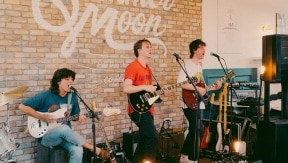
Why you should indulge in improvised practice sessions
In a previous article, we talked about good habits for effective and regular practice sessions as a musician and singer. Among these habits, we noted the importance of scheduling sessions so as not to let procrastination get the best of you. Improvised sessions are the next logical continuation of this work of planned technical and theoretical improvement. Once the fruits of your labor from regular practice are acquired, you can then let your creativity flourish in freer practice sessions. Allow us to explain.
Don't expect improv miracles without technical practice
The paradoxical aspect of improvisation is that it can also be scheduled. But then, you’ll say, can this still be considered improvisation? Of course! We’d even argue that if you pencil in an improv session, contrary to a scheduled session with specific, technical exercises, scheduled improv sessions can still be a means of constructive and relaxing practice. The idea behind an improv session, is after all, putting into practice all of the theories that you’ve worked so hard on. Improvising doesn’t necessarily mean that you pick up an instrument, start from scratch, and that by divine providence, you play angelic tunes with ease. Keep in mind that behind all good improvisers, there’s a former theory tyrant, who can finally reap the fruits of his laborious hours of technical practice.
Infinite possibilities
For many, improvisation signifies freedom. Having acquired great technical mastery, you are now free to sound your ideas without feeling limited by simply playing "what you are capable of." With a bit of trust in yourself and your competencies, you will be able to build a musical dialogue, help it evolve and even benefit in everyday life from this sweet feeling of fulfilment and freedom: your only limits become those of your imagination.
And when speaking about imagination, creativity in the moment that you play or sing is unlike any other: there are as many possibilities as there are moments or moods. Contrary to rigorously planned or written work, the purpose is not productivity but the pleasure and nourishing sensation of instant creation. After all, grabbing your instrument under the stars in summer will never deliver the same musical result as grabbing your instrument on a winter morning next to the fire, whereas in both situations, you could easily practice your range without trouble.
How to improvise
Bad news for the laziest among us: to master the art of improvisation, having "skipped" theory classes isn’t advised. Would you entrust the preparation of a meal to someone who has never cooked in his life on the pretext that he will more than likely have a great recipe fall from the sky? To spin the metaphor, a musician will add more or less spices in his basic dish to enhance it. But, never forget, it’s still necessary to know the basic dish.
Thus, different exercises can help you learn to improvise. The first, which will help you in all situations, is to master with your fingertips the pentatonic scale, in all positions and all tones. Why? Because this exercise’s main advantage it that it will help you adapt to the vast majority of songs.
Once this fundamental rule is integrated, you'll be free to be more or less "talkative" in your improvisation. Scrolling through your scales at the speed of light works your technique, while allowing you to "distill" the notes to convey more emotion. For example, know how to use the silences, which are not necessarily synonymous with hesitation but more so with expression. Learn also to use and control the sound space and rhythm. You will start to understand that one single note can say much more than a thousand ever could. When practicing, make sure to play two notes every four measures, then increase to six, don’t hesitate to vary and don’t be afraid of small "hiccups," learn instead to play along with them.
Other fun and effective exercises:
- explore setbacks to break your habits.
- avoid certain notes in order to work other notes.
- mimic the habits of your favorite artists to help you stand out.
- play with a blindfold, which prohibits playing "by visual reflex."
- schedule improvisation sessions with others and a sequence for everyone …
All of these are what we call "letting go," and that's what will ultimately allow you to excel in improvisation and find your style.
Published on: 5 March 2019



